Gujarat Board GSEB Textbook Solutions Class 10 Science Chapter 7 Control and Coordination Textbook Questions and Answers, Additional Important Questions, Notes Pdf.
Gujarat Board Textbook Solutions Class 10 Science Chapter 7 Control and Coordination
Gujarat Board Class 10 Science Control and Coordination InText Questions and Answers
Question 1.
What is the difference between reflex action and walking?
Answer:
Reflex action takes place without thought, i.e., it gives a reaction to stimuli. It is controlled by the spinal cord. It is an involuntary action. Walking takes place after thought, i.e., according to our wishes. It is controlled by a part of hind brain called cerebellum. It is a voluntary action.
![]()
Question 2.
What happens at the synapse between two neurons?
Answer:
Synapse is the gap between nerve ending of one neuron and dendrites of another. At synapse, the electrical impulse generated at dendrites of a neuron is passed on to dendrite of another neuron in the form of chemicals by axon ending of the first neuron. Synapse ensures that nerve impulse travels only in one direction. A similar synapse allows the delivery of impulse from the neuron to the other cells, like muscle cells.
Question 3.
Which part of the brain maintains posture and equilibrium of the body?
Answer:
Cerebellum, which is a part of the hind brain.
![]()
Question 4.
How do we detect the smell of an agarbatti (incense stick)?
Answer:
Smell of an incense stick is detected by the olfactory receptors located in the fore¬brain.
Question 5.
What is the role of brain in reflex action?
Answer:
Spinal cord is made up of nerves which supply information to think about. Thinking involves more complex mechanisms and neural connections. These are concentrated in the brain, which reacts to the stimuli and is the main coordinating center of the body. The brain and spinal cord constitute the central nervous system. They receive information from all parts of the body and integrate it. Hence, brain plays an important role in reflex action.
Question 6.
What are plant hormones?
Answer:
Plant hormones are chemicals present in plants which help to coordinate growth, development and responses to stimuli and environment. For example, auxins, gibberellins, cytokinins, abscisic acids are different plant hormones.
Question 7.
How is the movement of leaves of the sensitive plant different from the movement of a shoot towards light?
Answer:
The movement of leaves of a sensitive plant is neither towards, nor away from the stimulus touch; it is a non – directional movement (nastic movement) while movement of shoot is towards the stimulus like light; it is a directional movement (tropic movement).
Question 8.
Give an example of a plant hormone that promotes growth.
Answer:
Auxin is the plant hormone that helps in cell growth and elongation. Gibberellins promote growth of stem.
![]()
Question 9.
How do auxins promote the growth of a tendril around a support?
Answer:
When tendrils come in contact with any support, the part of the tendril in contact with the object does not grow as rapidly as the part of the tendril away from the object. This is caused by the action of auxin hormone. Less auxin occurs on the side of contact as compared to the free side. As a result, auxin promotes growth on the free side and the tendrils coil around the support.
Question 10.
Design an experiment to demonstrate hydrotropism.
Answer:
Aim : To demostrate hydrotropism.
Material Required : Tray, soil, seeds, water, pipe.
Procedure :
- Take a tray filled with soil.
- Plant a seedling in the tray at one end.
- To the other end add water to the soil with the help of a pipe as shown in the figure.
Observation : The root (radicle) of the plant seedling moves towards the wet soil. This shows that roots are positively hydrotropic.
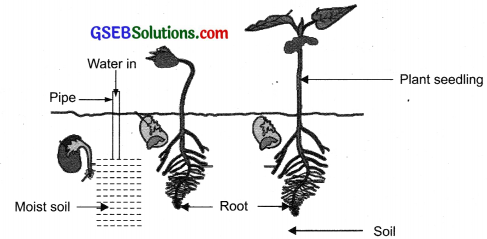
Question 11.
How does chemical coordination take place in animals?
Answer:
In animals, chemical coordination is maintained by hormones secreted by endocrine glands, which function as chemical messengers. They are released by endocrine glands directly into the blood without any involvement of special ducts from where they reach the target tissue or organ to act.
These organs and tissues then respond and enables the body to deal with different situations.
![]()
Question 12.
Why is the use of iodised salt advisable?
Answer:
Iodine is necessary for the thyroid gland to make thyroxin hormone. Thyroxin regulates carbohydrate, protein and fat metabolism in the body so as to provide the best balance for growth. If iodine is deficient in our diet, there is a possibility that we might suffer from goitre. The thyroid gland enlarges causing swelling in the neck. Iodised common salt contains proper content of iodine. Thus, to avoid deficiency of iodine, iodised salt is recommended.
Question 13.
How does our body respond when adrenaline is secreted into the blood?
Answer:
Adrenaline hormone is secreted in large amounts when a person is frightened, or mentally disturbed. When it reaches the heart, it beats faster to supply more oxygen to our muscles. The breathing rate also increases because of the contractions of diaphragm and the rib muscles. It also raises the blood pressure, and allows more glucose to enter into the blood. All these responses together enable our body to deal with the emergency situations.
Question 14.
Why are some patients of diabetes treated by giving injections of insulin?
Answer:
Diabetes is caused due to less or no secretion of hormone insulin by pancreas. In such a person, blood sugar level is high. Insulin converts extra sugar present in blood into glycogen. Thus, patients suffering from diabetes are given insulin injection to control their blood sugar level.
![]()
In-Text Activities Solved
Activity 7.1
Answer:
- Put some sugar in your mouth. How does it taste?
- Block the nose and now eat sugar. Is there any difference in its taste?
- While eating lunch, block your nose in the same way and note your observation.
Observation : We don’t get the same taste of food, sugar as we had earlier.
Activity 7.2
Answer:
- Take a conical flask with water.
- Cover its neck with the wire mesh.
- Keep two or three freshly germinated beans on the wire mesh.
- Take a cardboard box which is open from one side.
- Keep the flask in the box such that the open side of the box faces light coming from a window.
- After two or three days it is seen that the shoot bends and moves towards the light.
- Now rearrange the flask so that the shoots are away from light and the roots towards light. Leave it undisturbed for few day.
(i) The old parts of the root and shoot will change their direction.

(ii) There will be difference in the growth of shoot
(iii) From this activity we conclude that light is causing the movement growth in shoot of the plant. It is the response of the plant in the direction of light.
Activity 7.3
Answer:
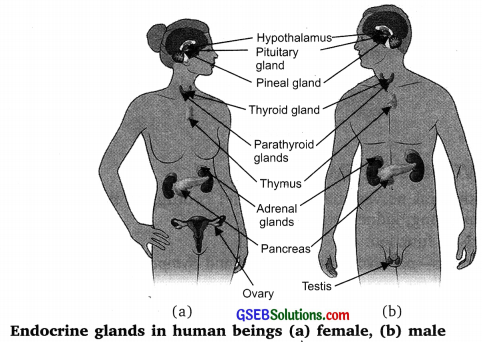
(i) Identify the endocrine glands mentioned in the figure and give function of these glands.
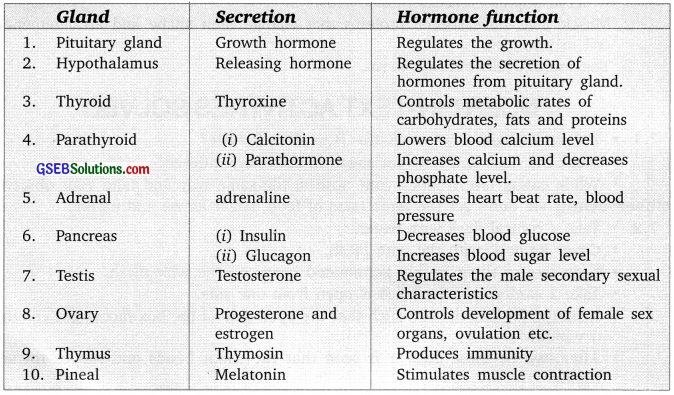
Activity 7.4
Answer:

Gujarat Board Class 10 Science Control and Coordination Textbook Questions and Answers
Question 1.
Which of the following is the plant hormone?
(a) Insulin
(b) Thyroxine
(c) Oestrogen
(d) Cytokinin
Answer:
(d) Cytokinin
Question 2.
The gap between two neurons is called a –
(a) dendrite.
(b) synapse.
(c) axon.
(d) impulse.
Answer:
(b) synapse.
![]()
Question 3.
The brain is responsible for –
(a) thinking.
(b) regulating the heart beat.
(c) balancing the body.
(d) all of the above.
Answer:
(d) all of the above.
Question 4.
What is the function of receptors in our body? Think of situations where receptors do not work properly. What problems are likely to arise?
Answer:
The receptors in our body collect information about, changes in the environment around us in the form of stimuli. They are located in our sense organs such as the inner ear, nose, tongue, eye, etc. These then pass the information in the form of nerve impulses to central nervous system (spinal cord and brain) where message is interpreted and instructions are sent to effectors which reveal responses. When receptors do not work properly, the environmental stimuli are not able to create nerve impulses and body does not respond.
Question 5.
Draw the structure of a neuron and explain its function.
Answer:
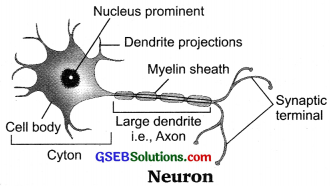
Functions : The information acquired at the end of the dendritic tip of a neuron sets off a chemical reaction which creates an electrical impulse. This impulse travels from the dendrite to the cell body, and then along the axon to its end. At the end of axon, the electrical impulse sets off the release of some chemicals, which cross the synapse and start a similar impulse in a dendrite of the next neuron.
In this way nervous impulses travel in the body. Thus, nervous tissue is made up of an organized network of neurons which are specialized for conducting information via electrical impulse from one part of the body to another.
Question 6.
How does phototropism occur in plants?
Answer:
Movement of shoot towards light is called phototropism. This movement is caused due to more growth of cells towards the shaded side of the shoot as compared to the side of shoot towards light. More growth of cells is due to secretion of auxin towards the shaded side. This can be proved with an experiment as detailed.

Aim : To show phototropism.
Material required : Conical flask, water, wire mesh, bean, seeds, cardboard box.
Procedure :
- Fill a conical flask with water.
- Cover the neck of the flask with a wire mesh.
- Keep two or three freshly germinated bean seeds on the wire mesh.
- Take a cardboard box which is open from one side.
- Keep the flask in the box in such a manner that the open side of the box faces the light coming from a window.
- Now, turn the flask so that the shoots are away from light and the roots towards light. Leave it undisturbed in this condition for a few days.
Observation :
- After two or three days, you will notice that the shoots bend towards light and roots away from light.
- The old parts of the roots and shoots change directions.
- New growth in shoot is in direction of sunlight.
Conclusion : Shoot shows phototropism.
Question 7.
Which signals will get disrupted in case of a spinal cord injury?
Answer:
- Reflex action
- Impulses from various body parts will not be conducted to brain.
- Message from brain will not be conducted to various organs of the body.
![]()
Question 8.
How does chemical coordination occur in plants?
Answer:
In plants, chemical coordination occurs with the help of plant hormones (phytohormones). Different plant hormones help to coordinate growth, development, and responses to the environment. They are synthesized at places away from where they act and diffuse to the area for action, for example, auxin promotes cell growth, gibberellins promote stem growth, cytokinins promote cell division and abscisic acid inhibits growth and its effects include wilting of leaves.
Question 9.
What is the need for a system of control and coordination in an organism?
Answer:
The body of a multicellular organism consists of a number of components and sub-components and each is specialized to perform a particular function. Therefore, it is necessary that various organs of the body of an organism work together in a proper manner for proper functioning to a stimulus. In human beings nervous system and endocrine system work together to control and coordination.
Question 10.
How are involuntary action and reflex action different from each other?
Answer:
(a) Involuntary action – involves autonomic nervous system.
- They occur in response to internal stimuli.
- They are connected with functioning of internal body parts.
- It occurs without the will of the organism.
Example – heartbeat, breathing, etc. - These are regulated by medulla oblongata (hind brain).
(b) Reflex action – involves all parts of voluntary nervous system though they are not voluntary.
- They operate against harmful stimuli which are generally external.
- They are connected with emergency i.e, response to stimuli.
- Some reflexes involve the brain, rather than the spinal cord.
- Reflex action is generally controlled by spinal cord.
![]()
Question 11.
Compare and contrast nervous and hormonal mechanism for control and coordination in animals.
Answer:
In human beings, the nervous system controls the various functions by small units called neurons. Neurons receive the information through sensory nerves and transfer them through motor nerves.
Whereas, hormones coordinate the activities and growth of the body. Important functions like sugar level metabolism, growth and development etc. are controlled by hormones secreted by endocrine glands. Hence, in human beings, hormones show long lasting responses. The action of hormoness highly specific.
Question 12.
What is the difference between the manner in which movement takes place in a sensitive plant and movement in our legs?
Answer:
Movement in a sensitive plant:
- It occurs in response to an external stimulus like touch and shock.
- Plant cells change shape by changing the amount of water.
- No nerves are involved.
- There is no specialized tissue in plants for conduction of information.
- Plant cells do not have specialized proteins.
Movement in our legs:
- It occurs in response to our requirements and is a voluntary action.
- Movement in our legs is voluntary action which is controlled by cerebellum part of hind brain.
- Nerves carry the message for movement of legs.
- There is specialized nervous tissue in animals for conduction of information and muscle cells to help in movement.
- Animal cells have specialized protein which help muscles to contract or relax.
Gujarat Board Class 10 Science Control and Coordination Additional Important Questions and Answers
Very Short Answer Type Questions
Question 1.
What is stimulus?
Answer:
Something that brings about a response in an organism is called stimulus.
Question 2.
What is an impulse?
Answer:
Information passes through our nerves in the form of electro – chemical signals. These signals are called impulse.
![]()
Question 3.
What is synapse?
Answer:
The functional junction between two neurons is called synapse.
Question 4.
What is reflex action?
Answer:
It is a spontaneous, involuntary and unconscious response to a stimulus.
Question 5.
Why is reflex action’important?
Answer:
Reflex action is important because it helps us to make quick responses to emergency situations. For e.g., jerking away our hand on touching hot iron.
Question 6.
Name the part of brain in which hypothalamus is located.
Answer:
Hind brain.
![]()
Question 7.
What part of the brain is responsible for precision of voluntary action?
Answer:
Cerebellum.
Question 8.
What is the impact of nervous electrical impulse upon muscle proteins?
Answer:
It helps in changing the shape and arrangement of proteins in muscle cells.
Question 9.
Which part of the brain is concerned with memory?
Answer:
Fore brain
Question 10.
How is brain protected from shocks and injuries?
Answer:
The brain box called skull protects the brain and it has the shock absorbing fluid in it.
Question 11.
Write the components of central nervous system.
Answer:
Brain and spinal cord.
Question 12.
Write the components of peripheral nervous system.
Answer:
Spinal nerves and cranial nerves.
Question 13.
Name two plant hormones that help in stem growth.
Answer:
Auxin and gibberellin.
Question 14.
What are cranial nerves?
Answer:
Nerves which originated from the brain are called cranial nerves.
![]()
Question 15.
Which nutrient of food is associated with muscular action?
Answer:
Proteins.
Question 16.
Name the hormone responsible for
(a) Phototropic movement of plant.
(b) Promoting cell division in plants.
Answer:
(a) Auxin
(b) Cytokinin
Question 17.
Name the stress and fear hormones.
Answer:
Adrenaline hormone.
Question 18.
What are photoreceptors?
Answer:
The receptors present in our eyes are called photoreceptors, as they are light sensitive.
Question 19.
What are gustatory receptors?
Answer:
The receptors present in our tongue which detect the taste are called gustatory receptors.
Question 20.
What are olfactory receptors?
Answer:
The receptors present in our nose and helps in detecting smell are called olfactory receptors.
![]()
Question 21.
Name the part of hind brain which takes part in regulation of respiration.
Answer:
Pons.
Question 22.
Name the structural and functional unit of human nervous system.
Answer:
Neuron.
Question 23.
What could be the possible disadvantage if reflex action were controlled by the brain?
Answer:
The action time would be longer and the response to any stimuli would have taken more time.
Question 24.
Why is pituitary gland called master gland?
Answer:
It is because pituitary gland controls and coordinates the secretions of all the other endocrine glands.
Question 25.
What are phytohormones?
Answer:
The hormones present in plants which are involved in the control and coordination of plant are called phytohormone.
![]()
Question 26.
Name any 4 stimuli which acts on plants.
Answer:
Light, water, gravity, touch and chemical substance.
Question 27.
Name one endocrine gland which performs dual function.
Answer:
Pancreas – It secretes hormones and digestive enzyme.
Question 28.
Name the components of neuron.
Answer:
Dendrite, cell body, axon and nerve ending.
Question 29.
Name the hormone secreted by thyroid gland.
Answer:
Thyroxine.
![]()
Short Answer Type Questions
Question 1.
Give protective features of the nervous system.
Answer:
1. The brain is protected by the bony cranium. The brain is also covered by three membranes called meninges. The space between the meninges is filled with cerebrospinal fluid which protects the brain from mechanical shocks.
2. The meninges and the cerebrospinal fluid cover the spinal cord too. Besides this the spinal cord is protected by the vertebral column.
Question 2.
How do nervous tissues bring about muscular movements?
Answer:
When a nerve impulse reaches the muscle, the muscle fibres move. This movement is brought about by the special proteins present in the muscle cells. These proteins change their shape and arrangement making the muscle cell shrinks. This makes the muscle cell contract.
Question 3.
What are tropic movements?
Answer:
Tropic movements are directional movements which are either towards the stimuli or away from it.
- Phototropism : Movement is in response to light : stem positive, root negative
- Geotropism : Movement is in response to gravity : stem negative, root positive
- Hydrotropism : Movement in response to water : stem negative, root positive
- Chemotropism: Growth of pollen tubes towards ovules.
![]()
Question 4.
How is the secretion of hormones regulated?
Answer:
The secretion of hormones is regulated by the feedback mechanism. For e.g., the rise of sugar level in the blood stimulates the pancreas to secrete insulin. When the blood sugar level falls, insulin secretion is reduced.
Question 5.
How do neurons transmit information?
Answer:
Information passes through neuron in the form of electro-chemical signals. These signals are called impulse.
When an impulse reaches the end of the axon it sets off the release of some chemicals. These chemicals cross the gap or the synapse and start a similar electrical impulse in a dendrite of the next neuron. A similar synapse allows the delivery of impulses from the neurons to other cells, like muscle cells or glands.
Question 6.
Give the difference between sensory and motor nerve.
Answer:
Sensory nerves – It takes the information from receptors and transmit it to brain.
Motor nerves – It transmits the information for action to be taken from brain to the effector organs i.e. muscles.
Question 7.
What are functions regulated by fore brain?
Answer:
The functions of fore brain (cerebrum and lobes) are:
Cerebrum – It has sensory area where information is received from sense organs. Motor areas are also present from where impulse are sent to effector organs.
It also contains specific regions for each kind of stimulus and its response is located e.g. there are specialized regions for hearing, smell and sight.
![]()
Question 8.
How is the movement of the leaves of the sensitive plant different from the movement of a shoot towards light?
Movement in leaves :
- It is non-directional.
- Movement is due to quick response to the stimuli.
- It is not related to growth.
Movement of Shoot:
- It is directional.
- It is due to slow response to the stimulus.
- It is related to growth.
Question 9.
Give the function of thyroxin hormone. Which endocrine gland secretes this hormone?
Answer:
Thyroid gland secretes the thyroxin hormone. Function: It regulates the metabolism of carbohydrates, fats and proteins.
Question 10.
Draw a neat labelled diagram of neuron.
Answer:
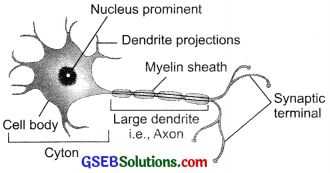
Question 11.
Give the characteristics of hormones.
Answer:
- They are specific chemical messengers.
- Secreted by endocrine glands.
- Directly poured into blood.
- Act on specific tissues or organs known as target organs.
Question 12.
Name the hormones released by the following:
- Ovary
- Testis
- Pancreas
- Pituitary
Answer:
- Ovary – Progesterone and Oestrogen.
- Testis – Testosterone
- Pancreas – Insulin and Glucagon
- Pituitary – Growth hormone.
Question 13.
What health disorder may occur if the following hormones are not secreted properly?
- Insulin
- Thyroxine
- Testosterone
- Growth hormone
Answer:
- Diabetes
- Goitre
- Masculine characters will not develop properly in male.
- Dwarfism if less hormone; Gigantism if secreted more.
Question 14.
What are plant hormones?
Answer:
Plant hormones are chemicals that bring about chemical coordination in plants. They help to coordinate growth, development and responses to the environment in plants. They are synthesized at places away from where they act and simply diffuse to the area of action.
Examples:
- Auxin – It is synthesized at the shoot tip and helps the stem to grow longer.
- Gibberellins – Help in vegetative growth of the plant.
- Cytokinins – Promote cell divisions and are present in high concentration in fruit and seeds.
![]()
Question 15.
What are the different parts of the brain? Give functions of each part.
Answer:
The brain is divided into three regions: fore brain, mid brain and hind brain.
Fore brain:
- The fore brain includes the cerebrum and the olfactory lobes.
- The cerebrum is the largest part of the brain and consists of two cerebral hemispheres.
- It has sensory areas where information is received from sense organs. Similarly there are motor areas
- from where impulses are sent to effector organs.
- In the cerebrum specific regions for each kind of stimulus and its response are located.
Example – there are specialized regions for hearing, smell and sight.
Mid brain:
- It is made up of thalamus and hypothalamus.
- It connects the fore brain to the hind brain.
Hindbrain – consists of cerebellum, pons and medulla:
- Cerebellum controls coordination, adjustment of movement and posture of our body.
- Pons regulates respiration.
- Medulla is the centre of involuntary actions like salivation, vomiting, sneezing coughing etc.
Question 16.
What is the role of adrenaline hormone that is secreted and released in the blood?
Answer:
Adrenaline acts on target organs and specific tissues as follows:
- Heart beats faster increasing the oxygen supply to the muscles.
- Muscles of ribs and diaphragm contraction increases thereby increasing the breathing rate.
- Blood vessels of the digestive system and skin contracts resulting in diversion of blood to our skeletal muscles.
Question 17.
Name the secretions of the following glands and give their function: pituitary, testis and ovary.
Answer:
Pituitary : It secretes growth hormone which regulates growth and development of the body. Excessive secretion causes gigantism and decreased secretion causes dwarfism.
Testis : Secretes testosterone which regulates male accessory sex organ and secondary sexual characters.
Ovary : Secretes oestrogen which regulates female accessory sex organs and secondary sexual characters in females.
Question 18.
Compare and contrast nervous and hormonal mechanism for control and coordination.
Answer:
Nervous coordination:
- It is brought about by a network of nerves which connect different parts of the body to the central nervous system.
- Messages are sent through nerves to different parts of the body.
- Nerves and the central nervous system control and coordinate different functions.
- There is no such mechanism in this as caused in hormonal coordination due to change in hormone quantity
Hormonal coordination:
- It is brought about by hormones secreted by endocrine glands into the blood and reaching different parts of the body.
- Messages are sent through hormones to different parts of the body.
- Every function is controlled and coordinated by special hormone.
- Increase and decrease of hormone quantity affect target organs.
Question 19.
Draw a neat labelled diagram of human brain.
Answer:
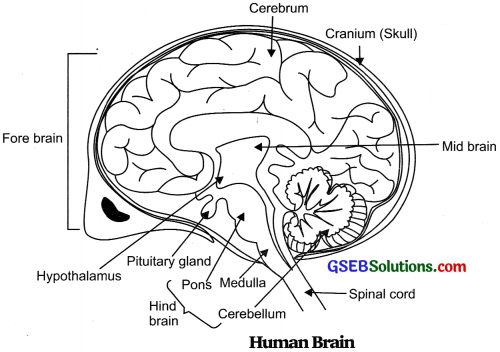
Question 20.
What is the difference between sensory and motor neuron? Which part of human brain is responsible for auditory reception and sensation of smell?
Answer:
- Sensory Neuron – It carries the stimulus from receptor ti the brain.
- Motor Neuron – It carries the impulse from brain to the effect organ.
![]()
Question 21.
Write down three main differences between auxin and cytokinin.
Answer:
Auxin:
- It promotes cell elongation.
- It promotes the growth of stem and
- It can cause formation of seedless fruits.
Cytokinin:
- It promotes cell division.
- It promotes the growth of lateral buds.
- It can retard ageing of plants.
Question 22.
Give difference between nervous system and endocrine system.
Answer:
Endocrine System:
- This system does not have direct connection with the organs or tissues controlled by it.
- The information of coordination is transmitted slowly.
- The effect is long lasting.
Nervous System:
- This system has direct connection and control over the tissues or organs.
- The information is transmitted very
- The effect is short lived.
Question 23.
Differentiate between the following:
(a) Spinal nerve and cranial nerve
(b) Dendrite and axon
(c) Central nervous system and peripheral nervous system.
Answer:
(a)
- Spinal nerve – It arises from spinal cord.
- Cranial nerve – It arises from brain.
(b)
- Dendrite – It arises from the cell body, short branched parts, that receive messages from the reception.
- Axon – It is a long unbranched part that comes from the cell body. Through axon the messages passes to another nerve cell.
(c) Central nervous system:
- It consists of brain and spinal cord.
- It contain centres for controlling various activities of the body
Peripheral nervous system:
- It consists of cranial nerves, spinal nerves and visceral nerve
- No such centres present for controlling as nerves only transmit the impulse.
Question 24.
Draw a diagram of human hormonal system.
Answer:
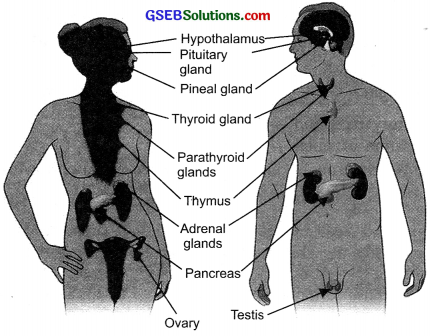
Question 25.
In our body what is the function of thyroxin hormone?
Answer:
Thyroxin hormone regulates the metabolism of carbohydrates, proteins and fats.
Question 26.
Name the endocrine gland that secretes insulin in our bodies.
Answer:
Pancreas.
![]()
Question 27.
Mention the functions of fore brain.
Answer:
Fore brain consists of three parts and each has its own functions
- Olfactory lobe – It is related to olfactory responses, sense of smell.
- Cerebrum – This controls muscular movements, visual, auditory responses, responses of touch, smell, temperature and conscious association.
- Diencephalon – It regulates water balance in the body, metabolism of carbohydrates and fats, controls feelings of anger, pleasure, fear, hunger, etc.
Question 28.
Name three different types of neurons and state the function of each.
Answer:
- Sensory neuron – These neurons receive signals from a sense organ.
- Motor neuron – These neurons send signals to a muscle or a gland.
- Association neuron – These neurons relay the signals between sensory neuron and motor neuron.
Question 29.
Give the detailed description of peripheral nervous system.
Answer:
The peripheral nervous system is composed of the cranial nerves and spinal nerves. There are 12 pairs of cranial nerves. The cranial nerves come out of the brain and go to the organs in the head region. There are 31 pairs of spinal nerves. The spinal nerves come out of the spinal cord and go to the organs which are below the head region.
![]()
Question 30.
What is autonomous nervous system?Describe its two types.
Answer:
The autonomous nervous system is composed of a chain of nerve ganglion which runs along the spinal cord. It controls all the involuntary actions in the human body. The autonomous nervous system can be divided into two parts:
(a) Sympathetic Nervous System – This part of the autonomous nervous system heightens the activity of an organ as per the need. For example; during running, there is an increased demand for oxygen by the body. This is fulfilled by an increased breathing rate and increased heart rate. The sympathetic nervous system therefore works to increase the breathing rate and the heart rate.
(b) Parasympathetic Nervous System – This part of the autonomous nervous system slows down the activity of an organ and thus has a calming effect. During sleep, the breathing rate slows down and so does the heart rate. This is facilitated by the parasympathetic nervous system.
Question 31.
Discuss the structure of human brain.
Answer:
Human brain is a highly complex organ which is mainly composed of the nervous tissue. The tissues are highly folded to accommodate a larger surface area in less space. The brain is covered by a three layered system of membranes called meninges.
Cerebrospinal fluid CSF is filled between the meninges. The CSF provides cushion to the brain against mechanical shocks. For optimum protection the brain is housed inside the skull. The human brain can be divided into three regions, viz. forebrain, midbrain and hindbrain.
- Forebrain: It is composed of the cerebrum.
- Midbrain: It is composed of the hypothalamus.
- Hindbrain: It is composed of the cerebellum, pons and medulla oblongata.
Question 32.
Discuss the functioning of muscles under the nervous control.
Answer:
Muscle tissues have special filaments called actin and myosin. When a muscle receives a nerve signal a series of events is triggered in the muscle. Calcium ions enter the muscle cells. It results in actin and myosin filaments sliding towards each other and that is how a muscle contracts. Contraction in a muscle brings movement in the related organ.
Question 33.
Why is the release of hormone important in our body?
Answer:
Hormones are produced in the endocrine glands. Hormone is mainly composed of protein. Hormones assist the nervous system in control and coordination. Nerves do not reach to every nook and comer of the body and hence hormones are needed to affect control and coordination in those parts. Although the nervous control is very fast , hormonal control is somewhat slower.
![]()
Question 34.
Plants show tropic movement for their survival. Describe and discuss these movements in plants.
Answer:
The following tropic movements are seen in plants:
(a) Geotropic Movement: The growth in a plant part in response to the gravity is called geotropic movement. Roots usually show positive geotropic movement, i. e. they grow in the direction of the gravity. Stems usually show negative geotropic movement.
(b) Phototropic Movement: The growth in a plant part in response to light is called phototropic movement. Stems usually show positive phototropic movement, while roots usually show negative phototropic movement. If a plant is kept in a container in which no sunlight reaches and a hole in the container allows some sunlight; the stem finally grows in the direction of the sunlight moving out through the hole.
This happens because of a higher rate of cell division in the part of stem which is away from the sunlight. As a result, the stem bends towards the light. The increased rate of cell division is attained by increased secretion of the plant hormone auxin in the part which is away from sunlight.
(c) Hydrotropic Movement: When roots grow in the soil, they usually grow towards the nearest source of water. This shows a positive hydrotropic movement.
(d) Thigmotropic Movement: The growth in a plant part in response to touch is called thigmotropic movement. Such movements are seen in tendrils of climbers. The tendril grows in a way so as it can coil around a support. The differential rate of cell division in different parts of the tendril happens due to action of auxin.
Question 35.
In the tabular form list all the hormones released by our body with the location, function and the glands involved in the making of it.
Answer:
The tabular form description:
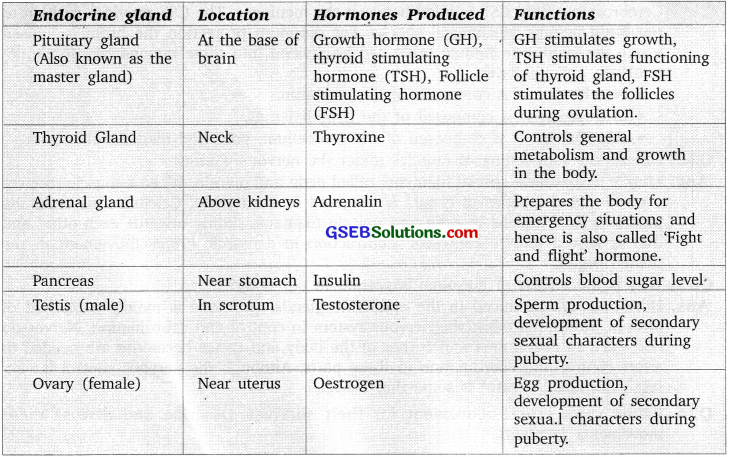
Question 36.
Explain homeostasis.
Answer:
Homeostasis is the maintenance of a constant internal environment, which is important for an organism to stay healthy. Slight fluctuations in body temperature, water levels and nutrient concentrations in body could lead to death. Hence homeostasis controls and regulates our body temperature. Mammals and birds are warm-blooded – they maintain a constant body temperature despite external environment changes. Human maintain a body temperature of 37 degrees C – we have mechanisms to lose heat when we get too hot, and ways of retaining heat when we get too cold.
Question 37.
State the functions of plant hormones. Name four different types of plant hormones.
Answer:
Phytohormones help in control and coordiantion in plants. The plant hormones also help in growth, vegetative growth, ripening of fruit and promotes to the stem cell divistion.
![]()
Long Answer Type Questions
Question 1.
(a) Label the parts of the nerve cell and give one function each.
(b) What are two limitations of electrical impulse?
Answer:
(a) 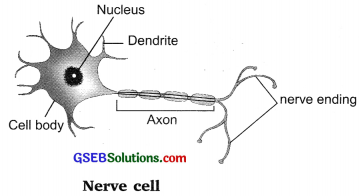
(i) Dendrite: It receives the impulse from the stimulus and transmit it further to the cell body.
(ii) Axon: Axon receives the message from dendrite and sends it further to nerve ending.
(iii) Nerve ending: It transmits or sends the signal to the other nerve cell via- synapse.
(b) Limitation of electrical impulse: Impulse reaches only those cells having nerve connections and it cannot continue to create the electrical impulse.
Question 2.
(a) Draw a well labelled diagram of neuromuscular junction.
(b) Describe the feedback mechanism.
Answer:
(a) 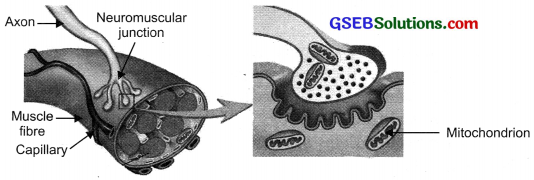
(b) Feedback mechanism: It helps in the secretion of hormones, timing and the amount of hormone to be released and regulated.
For example, if the blood sugar level increases then immediately pancreas secretes insulin in the required amount so as to release in blood and maintain ‘ the level of sugar in blood.
Question 3.
Define reflex arc and draw its labelled diagram.
Answer:
Reflex arc: It is the nerve path involved in a reflex action for quick responses. A message from the receptor is relayed by sensory nerves to spinal cord, which sends information for response in a motor nerve to the effector.
Example: hand touching hot object.
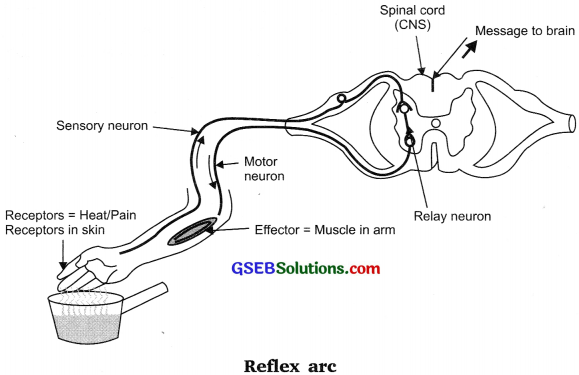
Question 4.
(a) Name five different types of movements with one example for each.
(b) Name five different hormones secreted by plants with one function for each.
Answer:
(a) Movements in plants:
- Phototropism – Stem tip grows in the direction of light.
- Geotropism – Response towards the gravity. E.g., roots grow towards pull of gravity.
- Chemotropism – Response due to chemicals, e.g., movement of pollen tubes towards a chemical is produced by the ovule during fertilization.
- Thigniotropism – Response to touch on tendrils and other climbing parts are positively thigmotropic.
- Nastic movement – It is neither towards nor away from stimulus e.g., touch me not plant leaves bend and droop on touching.
(b) Hormones:
- Auxin – They are produced at the shoot tip and help in growth of stem.
- Gibberellin – Helps in vegetative growth.
- Cytokinin – Promotes cell division.
- Abscisic acid – Inhibits growth and induces wilting of leaves.
- Ethylene – Helps in ripening of fruit.
![]()
Question 5.
Name any 5 hormones secreted by human beings with its glands and functions.
Answer:
(i) Growth hormone: Secreted by pituitary gland.
Function: It promotes the growth of long bones and muscles. Excess secretion of hormones leads to gigantism, insufficient secretion leads to dwarfism.
(ii) Thyroxin: Secreted by thyroid gland.
Function: It regulates carbohydrates, proteins and fats metabolism, accelerates energy production, stimulates absorption of glucose.
(iii) Insulin: Secreted by pancreas.
Function: It controls the rate of oxidation of glucose. If insulin is not present, blood glucose level will keep rising.
(iv) Adrenaline: Secreted by adrenal gland.
Function: It is released in time of stress and emotional disturbance. Excitement stimulates adrenaline secretion which increases heart beat, blood pressure and rate of respiration. It is called emergency hormone or fight or flight hormone.
(v) Testosterone: Secreted by testis.
Function: Helps in development of secondary sexual characters, e.g. moustache, beard etc.
Question 6.
What is meant by reflex-action? With the help of a labelled diagram trace the sequence of events which occur when we touch a hot object.
Answer:
When a receptor is stimulated, it sends a signal to the brain in the central nervous system, where the brain co – ordinates the response. But sometimes due to a very quick response the message passes from the spinal cord whithout the involvement of the brain. This is a reflex action.
Reflex actions are rapid and occurs without the involvement of brain hence no thinking takes place. For example, you would withdraw your hand awawy from a hot flame without thinking about it.
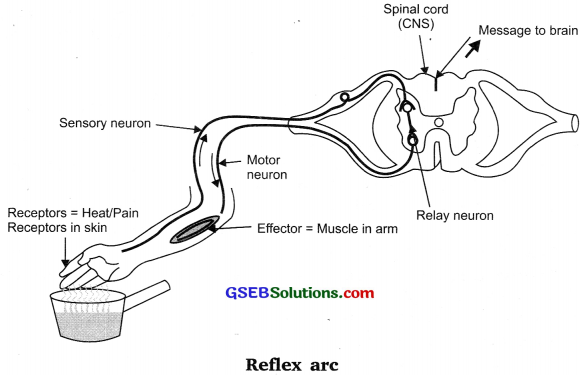
The sequence of the reflex arc are:
- Receptor detects a stimulus – affector/change in the environment
- On getting stimulus the sensory neuron sends signal to relay neuron.
- Relay neuron sends the message to motor neuron.
- Motor neuron sends signal to effector (for action to be taken/response)
- Effector produces a response (effector is a muscle)
![]()
Questions On Higher Order Thinking Skills (Hots)
Question 1.
Give the names of hormones responsible for the physical changes in a boy and girl.
Answer:
Boy- Testosterone Girl- Oestrogen
Question 2.
Name the element of halogen family required for the proper functioning of thyroid gland.
Answer:
Iodine.
Question 3.
A doctor advised a patient to take less sugar in her diet. Which disease is she suffering from?
Answer:
Diabetes, due to deficiency of insulin.
Question 4.
Name the stress and fear hormone.
Answer:
Adrenaline
Question 5.
Name the receptors of light, sound, smell and taste.
Answer:
Light: Photoreceptor e.g., eyes Sound: Phonoreceptor e.g., ear Smell: Olfactory receptor e.g., nose Taste: Gustatory receptor e.g., tongue.
Question 6.
A patient is not able to balance his body and cannot walk properly by keeping the balance and cannot coordinate it. Name the part of brain which is affected.
Answer:
Hind brain.
![]()
Question 7.
Name the hormone that controls the rate of respiration, also name the part of brain responsible for controlling respiration.
Answer:
Adrenaline hormone controls the rate of respiration (hormone). Pons (brain part) controls the rate of respiration.
Question 8.
Doctor advised a patient to take iodised salt. Explain why?
Answer:
Iodine present in iodised salt helps in the secretion of thyroxine by thyroid gland which controls the metabolism of carbohydrates fats and proteins.
Question 9.
What are the limitations of electrical impulse?
Answer:
It reaches only to target organs and it cannot recreate the signal again.
Question 10.
If there is no neuron in an organ, how will the message reach in other way?
Answer:
The messages can be sent by hormones if the nervous system or nerves lack.